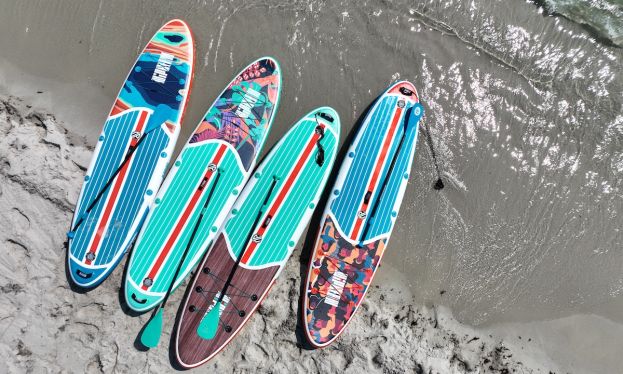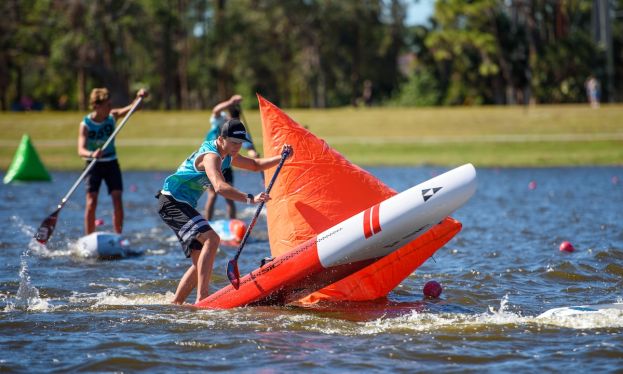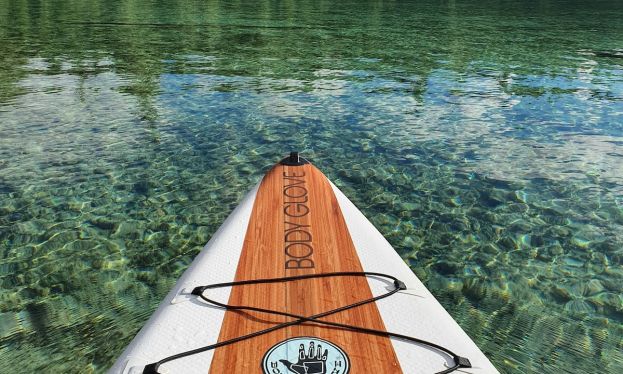5 Tips for Buying a Family SUP
- Written by Layne Pennell
- Published in Tips
- Comments::DISQUS_COMMENTS
ALBERTA, Canada - Purchasing a stand up paddle board for your family can be a daunting experience. Paddle boards are expensive, and many people are afraid to make the wrong decision when buying a SUP. Keep these tips in mind during your shopping process to help you make the right purchase decision.
1. Consider the Size and Age of Your Family
Who is going to be riding your new SUP? Are your children still growing rapidly, or are they pretty much done? Answering these questions provides baseline information that will guide you to the proper size of paddle board you should be considering for your family. Obtain the weights of each rider. If you have growing children, predict their approximate weights three to five years out. Now that you know how much each family member weighs, it’s time to look for a good, stable SUP. Remember this rule; the more displacement a paddle board has, the more stable it will be. Lighter weight riders will find any SUP more stable than heavier riders of the same ability.
Look for boards that have a stable displacement for the heaviest rider of your family. Lighter riders will find the board to be very stable, and the heaviest rider won’t become frustrated by having to ride a board that is less stable than his or her abilities would prefer. Paddle board displacement is measured in Liters. Beginners up to 200 lbs will find paddle boards with 190L of displacement quite stable. Other beginner Weight/Displacement Ratios includes 225lbs/215L, 250lbs/235L.
2. Get a Durable Board
Stand up paddle boards are expensive and children don’t always take care of things the way they should. Polyurethane shelled paddle boards are strong, tough and can take a beating, but they are heavy. Weights of 40 lbs+ are not uncommon for polyurethane SUPs. Fiberglass boards which make up the bulk of the market are much lighter then polyurethane ones, but they aren’t as durable. Better yet are bamboo stand up paddle boards like the ones made from Wappa Paddle Boards. These boards utilize the strengths of fiberglass with the added advantages of bamboo.
3. Get a Board That is Easy to Carry
Having to carry the SUP to the water and out every time a family member wants to go for a paddle quickly becomes tiresome. When shopping for a paddle board, you need to consider its weight. The 42 lb polyurethane unit seems like a good idea, but if your teenage daughter can’t carry it, you’re in trouble. Look for boards that weigh 25 lbs or less for easy carrying by the whole family.
Another factor which makes carrying a board easy is the type of SUP handle it has. Inflatable paddle boards have a strap attached to the deck to help you grab hold. Traditional hard paddle boards will have either an embedded hand grip, or a SUP handle that extends out from the board to provide a 1-2” extended handle, like those from SUP Think Tank. Of the two types, many paddlers prefer the embedded handle. It’s a natural fit that makes carrying a SUP very easy.
 Find a SUP that's easy to manage when your hands are full! | Photo via: iRocker
Find a SUP that's easy to manage when your hands are full! | Photo via: iRocker
4. Consider Your Activity Location
Where do you plan on doing most of your paddling? Are you mainly going to be on lakes, or do you want to take up surfing on the ocean as well? If the majority of your paddling are going to be on inland lakes, get a nice all around board with a bit of a square tail. This will keep the board nice and stable on the flat water. If you plan on doing some surfing, look at getting a pin tail. It will help you with your carving.
5. Feel Secure in Your Purchase
As you already know, stand up paddle boards are expensive. Even the cheapest inflatable boards are several hundred dollars. Most paddle boards are $1000+, so you should feel secure with your purchase. While security means different things to different people, there are two factors that should help all people feel secure; warranty and quality of construction.
 Photo Courtesy: SUPKlub
Photo Courtesy: SUPKlub
Warranty
What sort of warranty is provided by the manufacturer or seller? Many paddle board brands only offer a thirty day warranty while some offer one year. What does each warranty include and exclude? Look for brands that offer as long a warranty as possible. Ask yourself if you would be angry if the SUP you spent $1500 on had an issue two months after you purchased it and you had no warranty coverage. (Not saying that will happen).
Quality
How was the board made? Does the manufacturer show pride in the technology and materials that go into their product, or does it sell based solely on price. As with anything, better quality materials and a better construction method leads to a better made product. Ask questions to determine what went into the making of the SUP you are considering.
By keeping these five tips in mind during your shopping process, I’m confident that you’ll buy the right stand up paddle board for your family. Take your time, shop around, and examine each brand through the lenses of these tips.

Layne Pennell
Layne Pennell has been stand up paddle boarding for 10+ years and loves all aspects of the sport. After paddling daily while living in Mexico for several years, he returned to Alberta, Canada and brought his passion for SUP with him. Layne teaches paddle boarding to beginners, and his company Wappa Paddle Boards builds environmentally friendly bamboo stand up paddle boards.
Website: www.wappapaddleboards.com/ Email This email address is being protected from spambots. You need JavaScript enabled to view it.






